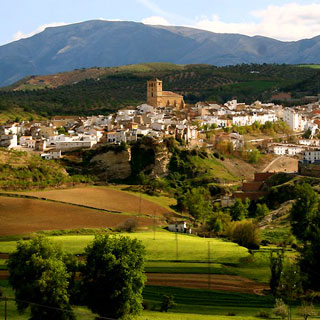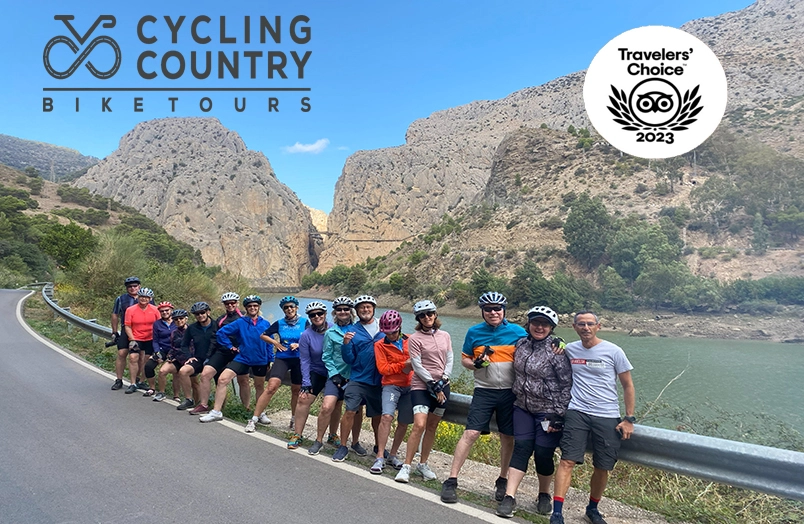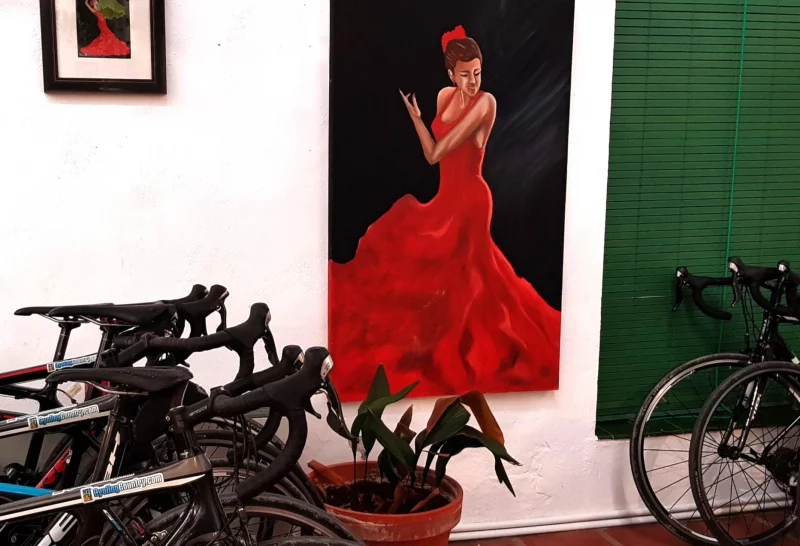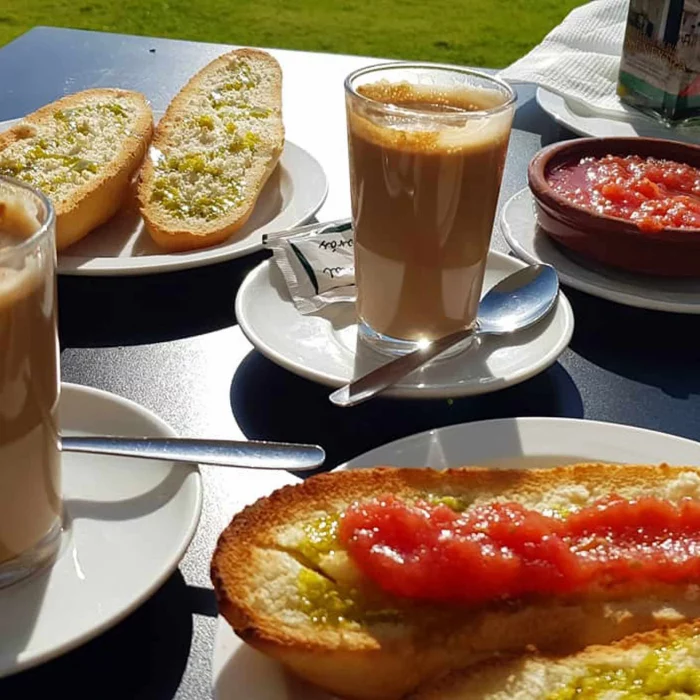
Cycling Country’s Headquarters in Alhama de Granada Gets a Facelift for 2025!
A renovation project on our cycling centre sheds light on hundreds of years of Andalucian building traditions. When you next pick up your hire bike from Cycling Country in Alhama, come and see the historic building we are based in for yourself!
Revamping for the Future
At Cycling Country’s headquarters in Alhama de Granada, we recently embarked on an exciting project: giving our workshop building a facelift. Stripping away the traditional whitewash plaster from the building’s façade, we were greeted by something unexpected—history in layers. Ancient building techniques that have shaped this region for centuries began to reveal themselves telling the story of Andalucía’s rich architectural heritage.
Read time: 10 min

Andalucía’s Glowing White Villages
Dazzling white villages under a deep cobalt sky—this is the iconic image of Andalucía. The homes, farmhouses (cortijos), and towns here are coated in a bright white plaster helping to reflect the powerful Andalucian sun. This ancient building tradition, dating back to the Phoenicians, was used to make homes cooler in the scorching summer heat. Indeed, the intense white reflects the sun’s rays, helping to keep interiors at a lower temperature.
Moorish Influence on Building Practices
During the period of Al-Andalus (from the 700s to 1492), the Moors ruled much of southern Spain and their influence on architecture is still evident today. Subsequently, it was the Moors who further developed the practice of whitewashing, using lime (cal), a natural mineral here to coat entire towns in Andalucía. The technique not only regulated the inside climate but also created a unity between the Islamic villages.
Today’s Plaster Facades Continue the Tradition
Our headquarters reflect this method, and the plaster facade of homes in Alhama de Granada’s are all painted in muted light lemons to dazzling whites due to this heritage. Undoubtedly, it makes for a picturesque and Instagrammable landscape.

Additionally to the bright white plaster, the narrow, twisting alleys found in many Andalucian villages were a clever design for both sun protection and defense. Certainly, these winding streets were strategically built to make it more difficult for invading forces to navigate. Therefore, creating a safer environment for residents and one they could more easily defend.
Cycling Country’s Reno removes this plaster
Keeping all of that in mind, it wasn’t without some trepidation, that upon, planning to renovate our workshop premises, we decided to strip off this plaster from our base and see what was under it.
“As an architect you design for the present with an awareness of the past for a future that is essentially unknown”.
Norman Foster


The Practice of Whitewashing Andalucian Homes
Cycling Country’s workshop is in a building that has all the elements of a traditional 19th and 20th century Andalucian village style. Windows guarded with wrought iron (rejas), wooden shutters (postigos) and of course an outer wooden blind (persiana). In addition, the blind could be also be made with esparto fibre grasses, to be dampened with cold water and when the wind blows, they become traditional “air-conditioners”! The fitting touch of course, is the building is in a blinding white, which on the lower floor, we were about to peel back.
Andalucian Whitewash Benefits
In the past, the whitewash used to coat Andalucian buildings was made by artisans called caleros. They crafted a mixture of slaked lime. Believed to act as both an insect repellent and a powerful disinfectant, it was painted on. In times of epidemics, such as plague, whitewashing homes was a common practice in an attempt to curb the spread of disease. This method was, and still is, commonly used in barns and stables worldwide as a way of maintaining cleanliness.
Buying Whitewash for your home
In fact, it was only 15 years ago that every Friday a van would roam Alhama’s streets calling out “Cal y Carbon“, in its door to door delivery. Cal to paint your home and carbon to warm it with the traditional under-the-table platter full of hot coals (brasero). Lighting the carbon coals under the table, and then covering the table with a large cloth, nicely warms your legs in Alhama’s cooler winters, and usually burns off all the rubber on your shoes!
Today, most cal is produced industrially, and the centuries-old artisan practice is in danger of disappearing. However, some regions near Sevilla, still celebrate this tradition. At the Museo de Cal de Morón, a UNESCO-recognized heritage site, visitors can explore 19th-century lime kilns and even take courses on learning traditional building methods.

Charming Pueblos Blancos: Andalucía’s White Villages
This architectural tradition has lead to one of the most iconic symbols of this area, Andalucía’s Pueblos Blancos (White Villages). These charming towns, nestled in the rolling hills of the Sierras, greet visitors with their glowing white facades and narrow streets. A visit to these villages feels like stepping back in time, to a simpler era without modern apps and email annoyances.
The true Pueblos Blancos are primarily found near Ronda in the Málaga/Cádiz region, an area known for its hilly countryside. These villages are especially captivating in the morning light, offering a picturesque view of the region’s traditional architecture. You can experience this first-hand on our White Villages Self-Guided Cycling Trip, where you’ll cycle through the stunning landscapes and quaint villages that define this region.

Traditional Andalucian Building Materials
Excitingly, when our whitewash plaster was stripped away, we could easily see that the traditional construction materials used reflected the region’s natural environment. In Alhama de Granada, buildings were primarily constructed using the area’s materials. The foundation of these homes was made from local limestone, while stones from the river Alhama, and mud and clay mixed with straw were used to create thick adobe walls. This technique was commonly employed in rural areas, where resources like wood were less abundant.
Spain’s gorgeous clay roof tiles
Roof tiles, also made from local barro (thick clay) are another iconic and romantic feature of all Andalucian homes, including Cycling Country’s. Adding to the region’s distinctive architectural style, these tiles were made and fired in nearby kilns. Structurally, the ceilings often feature beams made from pine or oak, with some higher-end homes incorporating wood like walnut. Originally, the plaster coating the walls was adhered to a layer of reeds from the nearby river beds, a clever way of ensuring durability and strength. When the office ceiling was re-plastered, the workman doing the plastering still used this technique!


Construction of Alhama de Granada, an Andalucian town
Alhama’s history stretches back even prior the Romans, but its fame as a Moorish stronghold in the defense of Granada is well known. The town’s strategic position atop a gorge, sheltered by mountains and hills, and the large battle that took place here helped marked the end of Moorish rule in Spain. In fact, Lord Byron himself wrote about the significance of this battle.
A Multi-Layered History: Revealing the Building’s Past
The building that houses Cycling Country’s headquarters in Alhama de Granada was originally constructed as a family home in the 1700s. Located near to the historic centre of Alhama and within sight of what would have been the walled centre of twisting alleys. Interestingly, the building was part of the initial wave of settlement after the Moors were overthrown in 1482. Branching out from the heart of the historic centre, consequently many neighboring homes still display fine stone doorway lintels and engravings dating from the 1700s. Significantly, it gives a glimpse into the past importance of this neighbourhood.
Re-building the past in a traditional Spanish home
When Cycling Country decided to remove the layers of white plaster “yeso” from our building due to ongoing humidity issues, it was a chance to uncover the layers of history hidden beneath. What we found was fascinating—a mix of repurposed stones and sturdy blocks, likely salvaged after the fall of the Moorish town. This rebuilding effort after the catastrophic earthquake of 1884 gave us a glimpse into the resilient nature of the builders who came before us. It’s a reminder that, much like the Giralda in Seville, many of the grandest structures in Spain are built on layers of history, with materials reused and recycled through time. Perhaps those great corner blocks that were uncovered were part of an important Moorish family’s home once? The river stones are plentiful, and pad these great blocks out in an interesting design.

Continuing our work in restoring this building reminds us of the marks left by past generations—like the tiny stone mason’s cross etched into the corner of the building (see photo). They are not only a testament to their skill but also their enduring presence. Often stone mason’s would carve their initials or tags into their works as a way of owning their workmanship but also a sign to get paid! Worker’s initials are found on many monuments, such as the Mezquita in Córdoba. And so their work lives on, and in uncovering these layers it connects us with the past and honours the artisanship that has shaped the Andalucía we know today.
A Look Back, and Ahead
Cycling Country’s headquarters now stands as a living piece of history, blending the old and new. Into 2025 and beyond, we’re not only preserving the beauty of Andalucía’s architectural heritage but also contributing to the ongoing story of this remarkable region.
Whether you’re cycling through the White Villages or visiting the historic centre of Alhama de Granada, every stone of Andalucía tells a story waiting to be uncovered.
Links
Travelling to experience Spain’s lovely white villages and towns?
- – Trains to/from Malaga including fast AVE train
- – Use Granada’s reliable ALSA coach system to get around.
- – Enjoy our 2025 Andalucian bike trips in the area





